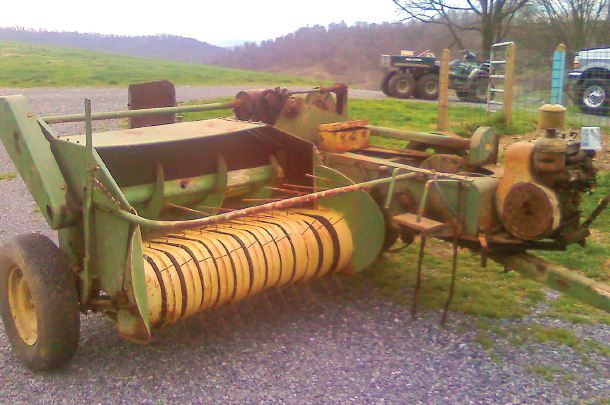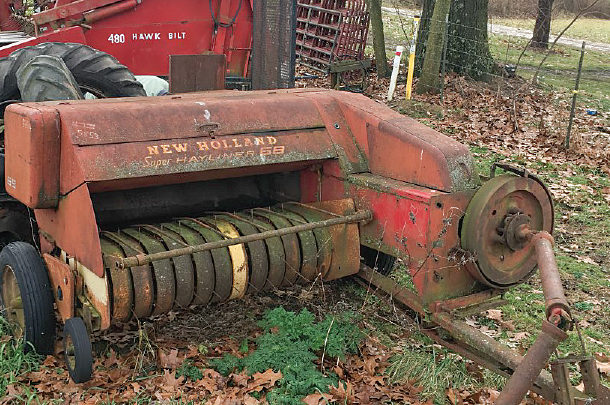Most were pull type, but there were a few self-propelled ones. Most early stationary balers were belt driven, while later pull-type balers were driven by power takeoff (PTO), and a lot even had their own power unit mounted directly on the baler. Lately, I have become very fond of these older contraptions. It may be because, as a kid, I rarely saw a square baling operation, and nowadays, the labor is so hard to come by most folks just don’t do it!
The first small square balers were stationary, meaning they had to stay in one place; the hay or straw had to be brought to it and fed by hand. When our club demonstrates the threshing machine, we have a stationary wire-tie baler setup ready to bale the straw. It takes a crew of three or four people to bale efficiently (if needing that many people to bale hay can be efficient). It got the job done back in the day, so I guess it worked. Pull-type balers were a big improvement over the stationary ones since they were able to pick up windrowed hay right out of the field. Some balers still used wire to tie, but most used twine.

At one time, I had a John Deere 14t and an International Harvester 45, each with two-cylinder Wisconsin THD engines. I still have two balers, the New Holland Super Hayliner 68 and 78. The 68 is a PTO, but it must have started its life with a Wisconsin, as I can still see where the mounting brackets were. The 78, which is a beast, uses a 30-horsepower VH4-D Wisconsin engine as its power plant.
When we found the 78 baler, it was still in the shed where the farmer left it the last time it was used. The Farmall M that pulled it was in another barn right where he parked it after unhooking the baler. The Farmall H he had used to mow the hay was in another barn with the mowing machine still hooked to it, and we were able to keep all these pieces together!
The front of the baler was just barely under the shed, which allowed water to blow into the exhaust of the motor, which over time lead to the demise of the engine. We got it home, removed the engine and took it straight to the machine shop to see what could be done for it. Since we already had it in the shop, we started going over the baler and checking everything we could so it would be ready when the engine came back. We then put brand new tires on it and moved it into a barn while we waited on the machine shop to get the engine back to us.
Now fast-forward about 10 years, which included my time in pharmacy school and a few years after. One day, the notion hit us to get back on the baler project, but we hit a bit of a snag. We couldn’t find the VH4-D engine or any part of it at all. We looked everywhere we normally store parts with no luck. One of our lifelong neighbors and best tractor buddies, Andrew, was by the shop a few days later, and we got to talking about the baler and the lost motor. After a while of brain-racking conversation, we determined that it must still be at the machine shop.
The next day, Dad went to the machine shop, and wouldn’t you know, they still had every single piece! They had done next to nothing to it, but they still had it all. It was piled up with a bunch of other stuff in a dark side room, so I guess it was “out of sight, out of mind” for them as well as for us. The crazier thing is that we had been to that shop numerous times during those years for all kinds of work, but there was never any mention of it by them or us – go figure.
After recovering the original engine, we found a really nice running VH4-D we couldn’t pass up. We have it mounted on the baler now, but we are still checking the baler and dealing with some chain and timing problems. When we get it back in service, I may have to include an update in a future issue.
Our tractor club has even considered doing a square bale demonstration so people can see how labor-intensive it really was. Mechanization has improved the process tremendously, whether it be through the use of a bale thrower or even an accumulator. A collector friend of mine has almost turned his square baling operation into a one-man show by using some of the latest and most innovative methods to do so. There are also the present-day large square balers, which seem to be gaining in popularity. The old way of doing things is becoming a lost art, and we need to see that the vintage methods of farming are preserved for years to come. ![]()
PHOTO 1: A New Holland Super Hayliner 68 square baler with PTO drive I bought from the original owner just down the road from my farm.
PHOTO 2: Our barn find: A John Deere 14t square baler with air-cooled Wisconsin THD mounted power unit. Photos by Lance Phillips.











